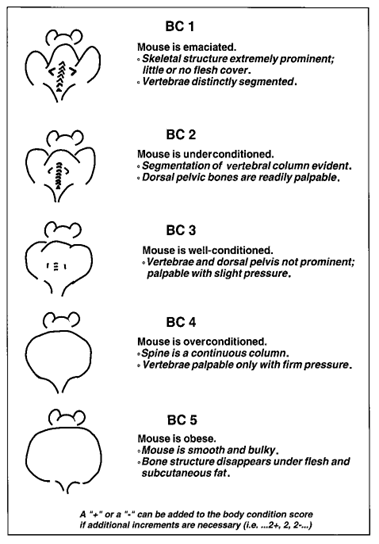IG029: Guideline for Tumor Burden Assessment in Rats and Mice
IACUC Guideline Number: IG029, Approved By: IACUC, Approval Date: 9/8/2022, Version: 5
This document provides guidelines for assessing tumor burden as part of spontaneous disease or experimental models in rats and mice.
Evaluating tumor burden based only on a percentage of body weight gained is generally not accurate since the growing tumor may cause an increase in overall body weight in an otherwise unhealthy animal. Please contact the Campus Animal Resources (CAR) Veterinary Staff (carvets@msu.edu) if additional guidance on body condition assessments is needed.
Tumor burden should be determined by evaluation of the Body Condition Score (see BCS figure below), size of tumor(s), anatomical location, incidence of multiple tumors, tumor appearance, and other clinical signs, as noted below.
1. All tumor-bearing rodents must be monitored to assess the progress of tumor growth and/or metastases. The animals should be assessed by the research staff with increasing frequency as tumors develop for the specific animal model. Clinical assessments are to be documented.
2. Animals showing any of the clinical signs listed below will be evaluated for euthanasia, unless an exemption is provided by the IACUC or the Attending Veterinarian:
- Mice: Superficial, solid and visible tumors are larger than 1 cm sphere (~ 523 mm3 in volume) or multiple tumors are cumulatively >2 cm
- Rats: Superficial, solid and visible tumors are larger than 2 cm sphere (~ 4184 mm3 in volume) or multiple tumors are cumulatively >4 cm
- Tumor mass affects the rodent’s gait or normal posture, ability to eat, urinate, or defecate, independent of the size of the tumor
- Significant weight loss from baseline (15% or more), failure to gain weight in otherwise young growing animals, or as compared to negative control animals, taking into account BCS of ‘1 out of 5’ (emaciated) or ‘2 out of 5’ (underconditioned)
- Respiratory distress (e.g., from lung metastases)
- Moribund (immobile) state
3. Additional clinical signs may be noted in unhealthy rodents and will necessitate a veterinary assessment:
- Tumors are discolored, ulcerated (any break in skin observed), or there are signs of infection at the tumor site
- Abdominal distension, indicating ascites or metastases
- Hunched posture
- Rough hair coat
- Failure to eat or drink
- Reluctance to move, lethargy or abnormal gait, or any other significant neurological impairment (blindness, circling, seizures)
Ascites produced by tumors and abdominocentesis
In cases where tumors are expected to grow with accumulation of ascites (fluid in the abdominal cavity), rodents must be weighed prior to tumor cell inoculation and subsequently be followed by weight measurements at regular intervals, as outlined in the protocol and based on the expected rate of fluid accumulation. When the body weight exceeds 120% of initial weight, the rodents should be euthanized or abdominocentesis (“abdominal tap”) should be performed to withdraw fluid and diminish abdominal pressure. In addition to weight measurement, BCS needs to be part of the evaluation of the animals, as mentioned above.
Abdominocentesis may only be performed by trained personnel up to three times per animal before humane euthanasia will be required at the time of the 3rd tap. Ascites pressure should be relieved before abdominal distension is great enough to cause discomfort, increased respiratory rate, or interfere with normal activity. The abdominal tap should be performed using proper aseptic technique, with manual restraint or anesthesia, and by using the smallest needle possible (e.g., 22 gauge) that allows for adequate fluid withdrawal.
Adverse effects of tumors
The known biology and effects of any individual tumor model should be described in the protocol, including expected clinical signs, anticipated adverse effects (e.g. metastases/moribundity/mortality), planned interventions for the relief of pain and discomfort, and objective criteria for the establishment of humane endpoints.
The CAR veterinary staff may request or require euthanasia at any time for humane reasons.
Body Condition Scoring
Body Condition Scoring (BCS) is a helpful adjunct for assessment of overall health of the animal

(For mice: Ullman-Cullere MH, et al., 1999)
(For rats: Hickman DL, et al., 2010))
Equations used to assess tumor dimensions
Measure the tumor in three dimensions
- d1 = length
- d2 = width
- d3 = thickness / height
Assume the tumor is a sphere or an ellipsoid and use this measurement
Alternatively, the following modified variant of this equation may be used:
Alfassi, Z.B., Boger, Z., and Ronen, Y., Statistical treatment of analytical data, Boca Raton (FL), CRC Press, 2005.
Kersemans V, Cornelissen, B, Allen PD, Beech JS, Smart SC. 2013. Subcutaneous tumor volume measurement in the awake manually restrained mouse using MRI. JMRI 37: 1499-1504.

